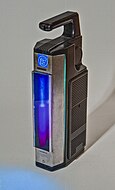Ultraviolet radiation occupies wavelengths between 10-400 nanometers on the electromagnetic spectrum. This invisible light carries more energy than visible light but less than X-rays, making up about 10% of the Sun’s total radiation output.
Historical Discovery
Johann Wilhelm Ritter discovered UV radiation in 1801 when he observed invisible rays darkening silver chloride-soaked paper faster than visible light. Scientists first called these “chemical rays” due to their reactive properties. By 1878, researchers identified UV’s ability to kill bacteria, and by 1903, they pinpointed 250nm as the most effective wavelength for sterilization.
Classification Types
UVA (315-400nm)
Long-wave UV passes through the ozone layer and reaches Earth’s surface. This range causes tanning and contributes to skin aging.
UVB (280-315nm)
Medium-wave UV mostly gets absorbed by the ozone layer. The small amount that reaches Earth causes sunburns and helps produce vitamin D.
UVC (100-280nm)
Short-wave UV never reaches Earth’s surface. The atmosphere completely blocks these highly energetic and dangerous rays.
Natural Sources
The Sun emits UV across all wavelengths. At Earth’s surface:
- 95% of UV is UVA
- 5% is UVB
- No UVC reaches the ground
Practical Applications
UV light serves multiple purposes:
- Sterilization and disinfection
- Chemical analysis and spectroscopy
- Medical treatments
- Manufacturing processes
- Security features
Protection Methods
Common materials block UV differently:
- Regular glass blocks UVB but passes some UVA
- Quartz glass transmits most UV wavelengths
- Specialized UV absorbers protect materials from degradation
- Sunscreens use organic or inorganic compounds to block harmful rays
Citations:
https://en.wikipedia.org/wiki/Ultraviolet
Ultraviolet radiation, also known as simply UV, is electromagnetic radiation of wavelengths of 10–400 nanometers, shorter than that of visible light, but longer than X-rays. UV radiation is present in sunlight, and constitutes about 10% of the total electromagnetic radiation output from the Sun. It is also produced by electric arcs, Cherenkov radiation, and specialized lights, such as mercury-vapor lamps, tanning lamps, and black lights.
The photons of ultraviolet have greater energy than those of visible light, from about 3.1 to 12 electron volts, around the minimum energy required to ionize atoms. Although long-wavelength ultraviolet is not considered an ionizing radiation because its photons lack sufficient energy, it can induce chemical reactions and cause many substances to glow or fluoresce. Many practical applications, including chemical and biological effects, are derived from the way that UV radiation can interact with organic molecules. These interactions can involve absorption or adjusting energy states in molecules, but do not necessarily involve heating. [citation needed] Short-wave ultraviolet light is ionizing radiation. Consequently, short-wave UV damages DNA and sterilizes surfaces with which it comes into contact.
For humans, suntan and sunburn are familiar effects of exposure of the skin to UV, along with an increased risk of skin cancer. The amount of UV radiation produced by the Sun means that the Earth would not be able to sustain life on dry land if most of that light were not filtered out by the atmosphere. More energetic, shorter-wavelength "extreme" UV below 121 nm ionizes air so strongly that it is absorbed before it reaches the ground. However, UV (specifically, UVB) is also responsible for the formation of vitamin D in most land vertebrates, including humans. The UV spectrum, thus, has effects both beneficial and detrimental to life.
The lower wavelength limit of the visible spectrum is conventionally taken as 400 nm, so ultraviolet rays are not visible to humans, although people can sometimes perceive light at shorter wavelengths than this. Insects, birds, and some mammals can see near-UV (NUV), i.e., slightly shorter wavelengths than what humans can see.



